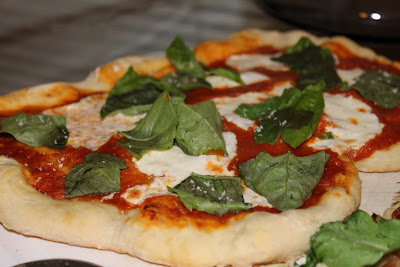Roasted Eggplant with Saffron Yogurt, Orange Segments, Arugula and Walnuts
and
-
- Garlic Hummus with Whole Wheat Pita Bread
- Whole Wheat Pita Bread
- 1 (1/4-ounce) package active dry yeast (2 1/2 teaspoons)
- 1 teaspoon honey
- 1 1/4 cups warm water (105–115°F)
- 2 cups bread flour or high-gluten flour, plus additional for kneading
- 1 cup whole-wheat flour
- 1/4 cup extra-virgin olive oil
- 1 teaspoon salt
- Cornmeal for sprinkling baking sheets
- Stir together yeast, honey, and 1/2 cup warm water in a large bowl, then let stand until foamy, about 5 minutes. (If mixture doesn't foam, discard and start over with new yeast.)
- While yeast mixture stands, stir together flours in another bowl. Whisk 1/2 cup flour mixture into yeast mixture until smooth, then cover with plastic wrap and let stand in a draft-free place at warm room temperature until doubled in bulk and bubbly, about 45 minutes. Stir in oil, salt, remaining 3/4 cup warm water, and remaining 2 1/2 cups flour mixture until a dough forms.
- Turn out dough onto a floured surface and knead, working in just enough additional flour to keep dough from sticking, until dough is smooth and elastic, 8 to 10 minutes. Form dough into a ball and put in an oiled large bowl, turning to coat. Cover bowl with plastic wrap and let dough rise in draft-free place at warm room temperature until doubled in bulk, about 1 hour.
- Punch down dough and cut into 8 pieces. Form each piece into a ball. Flatten 1 ball, then roll out into a 6 1/2- to 7-inch round on floured surface with a floured rolling pin. Transfer round to 1 of 2 baking sheets lightly sprinkled with cornmeal. Make 7 more rounds in same manner, arranging them on baking sheets. Loosely cover pitas with 2 clean kitchen towels (not terry cloth) and let stand at room temperature 30 minutes.
- Set oven rack in lower third of oven and remove other racks. Preheat oven to 500°F.
Transfer 4 pitas, 1 at a time, directly onto oven rack. Bake until just puffed and pale golden, about 2 minutes. Turn over with tongs and bake 1 minute more. Cool pitas on a cooling rack 2 minutes, then stack and wrap loosely in a kitchen towel to keep pitas warm. Bake remaining 4 pitas in same manner. Serve warm.











